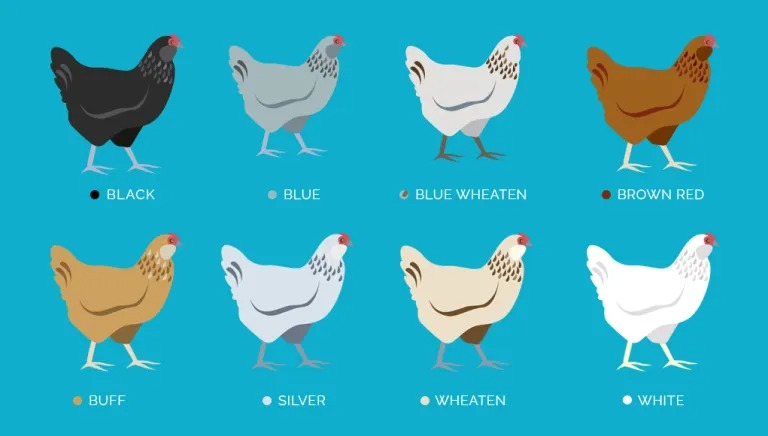Chicken feathers come in a rainbow of colors, ranging from black and white to red, brown, buff, gray, lavender and more. The specific color of a chicken depends on its breed, genetics, diet and age. Understanding chicken feather colors provides insight into breeds and chicken genetics.
Common Chicken Feather Colors
Here are some of the most common feather colors seen in backyard chickens
-
Black – Solid black feathering, caused by melanin pigment. Common in Australorps, Orpingtons and Silkies.
-
Blue – A black/gray color resulting from diluted black pigment Seen in breeds like Wyandottes and Andalusians,
-
Brown – Shades of brown caused by melanin. Includes reddish-browns, chocolate browns, buffs and more. Dominant in Plymouth Rocks, Orpingtons and Rhode Island Reds.
-
White – Lack of pigment produces solid white feathers. Dominant in Leghorns, Sussex and Silkies.
-
Red – Varying shades of reddish-brown caused by melanin. Seen in Rhode Island Reds, Buckeyes and Jersey Giants.
-
Gray – Mix of white and diluted black pigment. Occurs in Silkies, Blue Andalusians and Lavender Orpingtons.
-
Buff – Golden orange shade caused by pigment. Dominant in Buff Orpingtons.
-
Silver – White feathers with a shiny, metallic sheen caused by structure. Seen in Wyandottes and Lakenvelders.
What Determines Chicken Feather Color?
Chicken feather color is influenced by:
-
Genetics – Each chicken has genetic factors that control pigment production and expression. This determines the base color and patterns.
-
Breed – Specific breeds have been selectively bred for certain feather colors and patterns over time.
-
Diet – Diet can impact feather color, especially carotenoid pigments from feed that produce reddish hues.
-
Age – Chickens often fade or get lighter feathers as they molt and age. Younger chickens may be darker.
-
Health – Sickness and stress can impact melanin and cause paler feather coloring.
Common Chicken Breeds by Color
Here are some chicken breeds categorized by their most common feather colors:
Black
- Australorp
- Ayam Cemani
- Jersey Giant
- Orpington
- Silkie
White
- Leghorn
- Minorca
- Silkie
- Sussex
Brown
- Australorp
- Brahma
- Buckeye
- Chantecler
- Jersey Giant
- Marans
- Orpington
- Plymouth Rock
- Rhode Island Red
- Wyandotte
Red
- Buckeye
- Cornish
- Malay
- New Hampshire Red
- Rhode Island Red
- Sussex
Gray
- Andalusian
- Cochin
- Silkie
Buff
- Brahma
- Orpington
- Plymouth Rock
Silver
- Lakenvelder
- Hamburg
- Polish
- Sebright
- Wyandotte
Genetics Behind Chicken Feather Color
The main pigments that produce chicken feather colors are:
-
Melanin – Produces black, browns, reds.
-
Carotenoids – Produces yellows, oranges.
-
Porphyrins – Produces reds, browns.
Specific genes control the production, distribution and dilution of these pigments. Selective breeding leads to breeds fixed for certain colors and patterns.
Some examples of color genetics:
-
The C gene produces black vs yellow skin and feathers.
-
The E gene dilutes black to produce blue/gray shades.
-
The S gene produces silver/white markings.
-
The Ig gene dilutes red shades to produce fawn and cream.
Do Chicken Feather Colors Change?
Chicken feather colors can change as the bird ages for a few reasons:
-
Molting – Chickens gradually replace all feathers during the annual molt. New feathers may emerge a different shade.
-
Fading – Sun exposure, abrasion and other wear can cause feathers to fade over time.
-
Stress – Stress and illness can impact pigment production leading to paler colors.
-
Diet Change – Carotenoid intake affects red/yellow hues. A change in diet can change feather color.

Perfecta Oxholm Perfecta identifies as multiracial and explores race, parenting, and more worthwhile topics on her blog.
Join the EmbraceRace community! You will receive the newsletter with our latest on race & kids, including upcoming events and opportunities, resources, community news and curated links.
A chickens earlobe can tell you the color of the egg!
FAQ
What color is a chicken?
Chickens come in a dazzling array of feather colors, from the deep, glossy black of the Ayam Cemani to the delicate, creamy white of the Silkie. These body colors are not just for aesthetics; they also reflect the breed’s genetic heritage and can influence their adaptation to different environments.
What color meat is chicken?
Chicken is a widely consumed white meat. Various factors have resulted in debate centering on the definition of white and red meat. Dark meat is used to describe darker-colored flesh.
What color is chicken supposed to be?
Chicken meat cooks to a creamy-white color—unlike the more robust hues of cooked beef, pork, or lamb.
